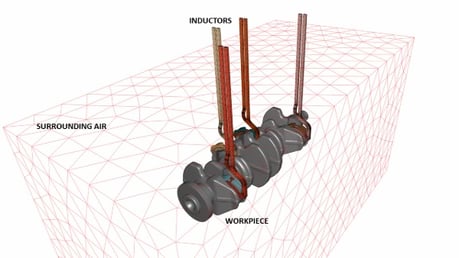Induction heat treatment modeling adapted to heat treatments
Transvalor has developed a process simulation model based on electromagnetic induction. This model is particularly suitable for induction quenching and it makes it possible to optimize the process parameters, such as for example the frequency of the current, the duration of the operation, the movement of the part or of the inductors, etc.
This model is integrated into our latest SIMHEAT® software launched in 2019, entirely dedicated to the simulation of heat treatment processes.
The induction model is continually improved by our software development teams, in order to best represent mechanical, electromagnetic and metallurgical phenomena, but also to be less costly in terms of IT resources and computing time for our users.
Today, our developments concerning the induction heating process modeling are focused on:
- Adaptation of the meshing to the electromagnetic field, to improve the link between the results quality and the CPU time
- Adaptation of the meshing, to follow displacements and distorsions
Towards the improvement of the induction process remeshing
A doctoral student of the CEMEF (material forming center) share his time with Transvalor to conduct a thesis which will allow to improve the induction model.
Subject: "Advanced numerical modeling for induction heat treatment process"
Objectives:
- Automatic remeshing adapted to electromagnetic issues
- Respect of surface interfaces: solid/air - solid/solid
The main strategy is to test and propose a posteriori error estimators, which can be implemented on the electromagnetic fields of our software. On this basis, it will be possible to carry out adaptive remeshing in order to obtain better spatial discretization of the models with a smaller number of elements.
This research will make it possible to drastically reduce the computing times without losing precision in the results.

Crankshaft Induction Heating with SIMHEAT®



